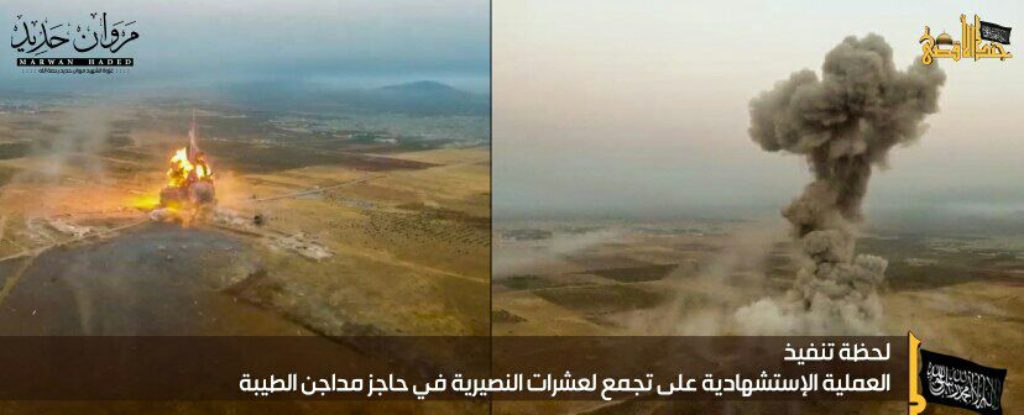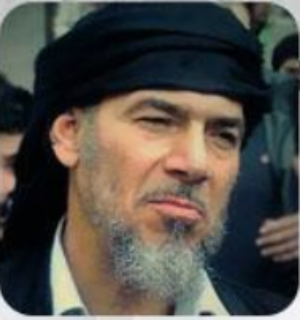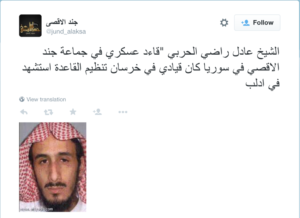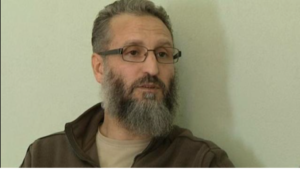
The State Department announced today that Jund al Aqsa, an al Qaeda front group in Syria, has been added to the US government’s list of specially designated global terrorist organizations. State notes that Jund al Aqsa “primarily operates in Idlib and Hama provinces” and was responsible for the February 2014 “massacre in the village of Maan in central Hama province, killing 40 civilians.”
Jund al Aqsa was established in 2012 as a “subunit” of Al Nusrah Front, al Qaeda’s official branch in Syria, but “split” from Nusrah and “now carries out operations independently.” Despite operating on its own, Jund al Aqsa “is still openly aligned with” Nusrah.
Indeed, the jihadist organization routinely participates in battles alongside Nusrah. Two Jund al Aqsa suicide bombers helped pave the way for a Nusrah-led offensive in Idlib province in March 2015. In addition, a contingent of Jund al Aqsa leaders reportedly joined Nusrah in February.
Jund al Aqsa endorsed Nusrah’s rebranding, remains loyal to al Qaeda
The emir of Nusrah, Abu Muhammad al Julani, announced on July 28 that his group had been rebranded as Jabhat Fath Al Sham (JFS, or the “Conquest of the Levant Front”). Julani said at the time that he and his men had “no affiliation to any external entity.” That phrasing was widely interpreted as meaning that Nusrah had broken off from al Qaeda.
However, Julani, who was dressed like Osama bin Laden during his announcement, did not explicitly say that he had split from al Qaeda. Julani made no mention of his bay’ah (oath of allegiance) to Ayman al Zawahiri. And al Qaeda itself is not an “external entity,” as it has senior figures inside Syria. Al Qaeda has long sought to obscure its role in the Syrian rebellion and Nusrah’s rebranding is entirely consistent with Ayman al Zawahiri’s original strategy for the multi-sided war. In fact, Zawahiri’s own deputy, Abu Khayr al Masri, blessed Julani’s move beforehand.
Jund al Aqsa’s “general command” endorsed Nusrah’s rebranding in a carefully worded statement released on July 31. The organization made it clear that al Qaeda’s leadership was responsible for Nusrah’s repositioning in the Syrian insurgency.
Jund al Aqsa’s leaders said they were optimistic about Al Nusrah’s “new garb,” or new appearance. They added that al Qaeda’s emirs and clerics must have carefully deliberated the move, determining that it was in the best “interest” of both the people and the jihad in Syria. In so deciding, Jund al Aqsa’s men said, al Qaeda’s leaders have once again proven their “sacrifice” in service of the ummah (worldwide community of Muslims). The jihadists “can [use] any name” they want, the statement continued, so long as they stay true to the principles of the “prestigious first generation of mujahideen” and follow the Prophet Mohammed’s “methodology.”
Jund al Aqsa’s leadership wrote that they hoped Al Nusrah’s rebirth as Jabhat Fath al Sham would lead to the creation of a new “Islamic authority” that governed according to sharia law, protected the lives of the people, and yet remained truly “independent.” The al Qaeda group did not say that Jabhat Fath al Sham was such a government, but instead that it would hopefully be a “prelude” to the creation of one.
There has been some confusion in the reporting on Jund al Aqsa, especially because some members have defected to the Islamic State. It is also likely that Abu Bakr al Baghdadi’s “caliphate,” which is a rival to al Qaeda, has infiltrated Jund al Aqsa’s ranks. Sporadic reports indicate that cells within Jund al Aqsa have targeted their own comrades in Idlib and elsewhere. Jund al Aqsa and Ahrar al Sham, another al Qaeda-linked group, may have also clashed at times.
But this doesn’t mean that Jund al Aqsa itself has defected to Baghdadi’s cause. As Jund al Aqsa’s July 31 statement made clear, the group remains loyal to al Qaeda’s senior leadership. This is unsurprising as al Qaeda has embedded key operatives in its ranks.
Al Qaeda veterans have led Jund al Aqsa
Jund al Aqsa was founded by Sheikh Abdul Aziz al Qatari, who reportedly fought for al Qaeda in Afghanistan.

According to the Syrian Observatory for Human Rights, Qatari (pictured on the right) was “close to” Osama bin Laden, Ayman al Zawahiri and Abdullah Azzam (bin Laden’s ideological mentor). Qatari fought in Chechnya and also in Iraq, where he was allied with Abu Musab al Zarqawi, the founder of al Qaeda in Iraq.
Qatari died under mysterious circumstances in 2014. Jund al Aqsa blamed the Syrian Revolutionaries Front (SRF), which was backed by the West before being disbanded, for Qatari’s death. In late 2014, Nusrah and Jund al Aqsa worked together to clear the SRF from several towns and villages. The offensive helped set the stage for Jaysh al Fateh, a coalition led by Nusrah and its allies, to sweep through Idlib province several months later.

In April 2015, Jund al Aqsa mourned the death of its military commander, a Saudi named Adel Radi Saker al Wahabi al Harbi. His death notice (seen on the right) was posted on Twitter.
Harbi was a senior al Qaeda operative wanted by the US government, which offered a reward of $5 million for information leading to his whereabouts. According to the US Treasury Department, al Harbi had served as the deputy leader of al Qaeda’s network in Iran prior to relocating to Syria.
Harbi worked for Muhsin al Fadhli in Iran. Fadhli himself relocated to Syria, where he became a key figure in al Qaeda’s so-called “Khorasan Group” before meeting his own demise in July 2015.
In May 2015, another al Qaeda member, Said Arif, was killed while leading Jund al Aqsa’s forces. The US State Department had previously designated Arif as a terrorist, identifying him as an “Algerian army officer deserter, who traveled to Afghanistan in the 1990s, where he trained in al Qaeda camps with weapons and explosives.”

Arif was implicated in multiple al Qaeda plots against targets in Europe. State described him as “a long-time terrorist who was a suspect in” al Qaeda’s “December 2000 plot to bomb the Strasbourg Christmas market.” He was arrested in 2003 and tried in France along “with 25 others,” all of whom were accused of belonging to the “Chechen Network,” which plotted “to blow up the Eiffel Tower” and launch “chemical attacks…on malls and police stations in France.” Arif was convicted in 2006 “for his role in these planned attacks.” After his arrest, State reported, Arif threatened that al Qaeda was “planning to attack an American military base in Spain using chemical weapons.”
Jund al Aqsa’s continuing loyalty to al Qaeda’s leadership, as well as the presence of Harbi and Arif in its ranks, indicates that the group may be used as a front for anti-Western plotting in the future.
To date, however, Jund al Aqsa has largely focused on the jihadists’ war inside Syria. The group regularly produces propaganda from the fighting in Hama and elsewhere. And on Sept. 19, Jund al Aqsa issued a series of tweets endorsing a proposed merger of rebel groups with Jabhat Fath al Sham, as long as the others remained true to the jihadi cause. As The Long War Journal reported in January, this was one of the key reasons for Al Nusrah’s rebranding in the first place. Al Qaeda wants to pool the insurgents’ resources, thereby masking its influence and increasing the jihadists’ efficacy in the war against Bashar al Assad’s regime.







